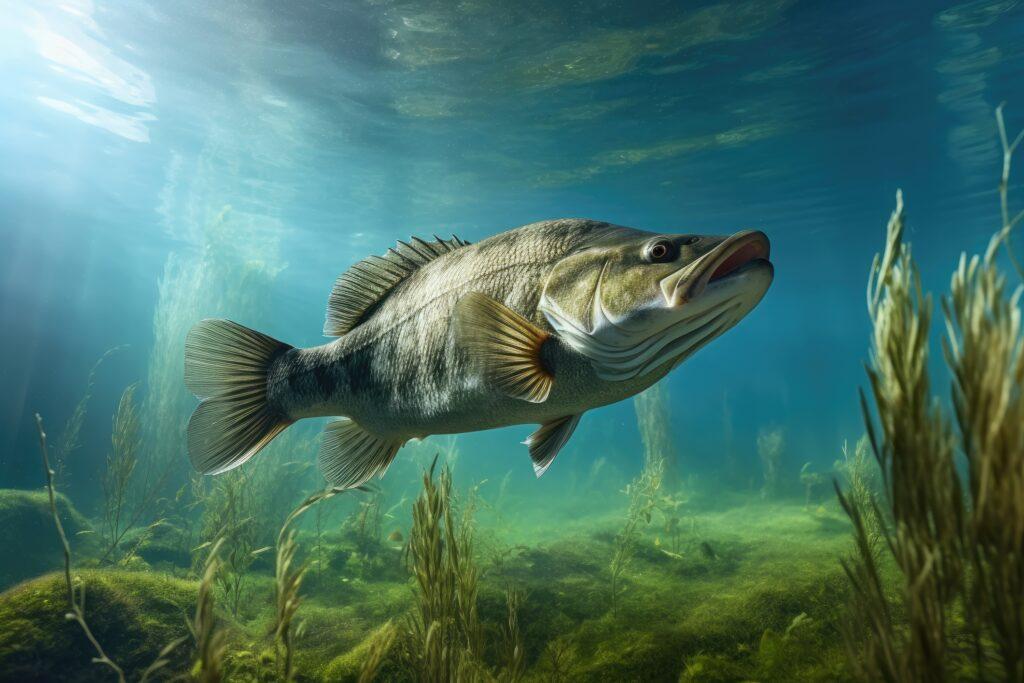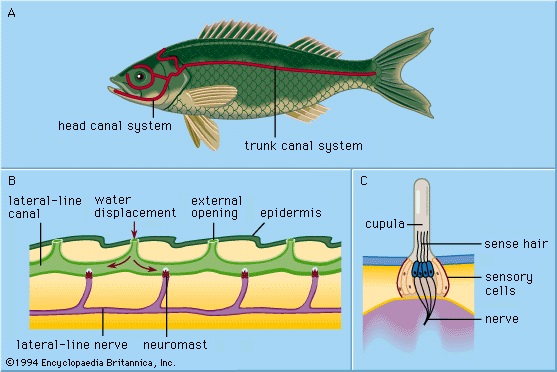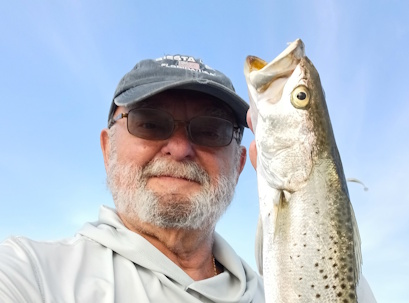Stealth Overview

Redfish – Red Drum searching shallow water for food. Redfish is a game fish found in the Atlantic Ocean from Massachusetts to Florida and in the Gulf of Mexico from Florida to northern Mexico.
The techniques I discuss here, for the most part, pertain to shallow water fishing tactics in lakes and saltwater shallows. In fact they also play a big part in successful fishing for Native Brook trout in cold New England streams… something I remember fondly from childhood when I was 10 years old.
For saltwater that means Inshore fishing and Nearshore fishing typically in depths less than 10 feet and often only 1 foot. The same approximate depth ranges can also be applied to freshwater fishing. For example, if you are approaching a feeding school of Redfish in waters as shallow as 12 inches, such as in the image above, then any errant noise or quick movement could spook the entire school, and you might be faced with spending hours looking for another school. Also, if you are fishing a clear Northern spring-fed Lake for largemouth bass in 15 ft of water they will be able to see you and your boat, especially if the sunlight is bright.
Even when fishing deeper water, such as over a reef 50 to 100 feet down, sound vibrations will easily carry that far. Usually that will not spook the fish living at that depth but, on a slow fishing day, a degree of stealth might make a big difference.
Mindfulness
It is a good idea to practice mindfulness while fishing. A good image to keep in mind is of you blending in with the surrounding natural environment. Fishing in such a way that your presence blends into the harmony of the environment can make the difference between a successful catch and a long, uneventful day. It’s all about harnessing the quiet, turning every moment into an opportunity to catch the trophy you have been fishing for.

Trophy Largemouth Bass facing the surface in shallow water looking for prey
Fish that have lived long enough to grow to a trophy size have become wary of anything out of the ordinary and will notice any change in their surroundings that might indicate danger. In the wild, survival of the fittest, fastest and wariest becomes a rule of life. Any unusual movement or vibration may signal the presence of a larger predator seeking to devour them for dinner. Here are a few things to keep in mind.
Stealth isn’t just about staying physically silent; it’s an intricate dance with nature, where every sensed movement and sound matter. Fish are intrigued by life above the waterline, but they’re also terrified of disturbances. Any unexpected sound or movement can send them darting for cover, leaving you with nothing but stories of what might have been.
So why is quiet so critical? Fish respond to disturbances the way we’d react to an unexpected noise on a dark night; they scatter, get defensive, and hide. Understanding this fish psychology can hugely impact your success rate. Some fishermen will say that bigger trophy fish are “smart”, while others maintain that fish are basically stupid and just “reacting to instinct”. I say that it doesn’t matter to which theory you ascribe the fish’s behavior. It just is. And it’s better to be aware of it.
Our predecessors, like the clever anglers of yore, always knew the value of quiet. Tales from various cultures speak of ancient anglers who mastered whispering to the winds and remaining unseen to make the perfect catch. This isn’t just folklore; it’s a time-tested method of blending patience with stealth.
Of course, I’m not asking you to tiptoe around the fishing spot like some zen warrior. But being mindful, mindful of every sound and movement, genuinely respects the process and ups your game significantly.
Sounds of the Deep: How Fish Sense and React to Noise

Here is a picture of a nice Snook in which the black Lateral Line of the fish can be seen quite clearly.
Fish can sense sound vibrations via the lateral line. Fish use their lateral line system, a network of sensory receptors located under their skin, to detect vibrations and movements in the water, essentially allowing them to “feel” sound vibrations. While fish do have ears, they provide limited hearing ability. However, a simple noise like bumping your fishing rod against the boat hull or even the trolling motor stopping and starting, thus sending out vibrations, can spook a whole school of feeding fish and they will be gone
A fish’s lateral line picks up sound by detecting water vibrations through a series of sensory cells, called hair cells, located within fluid-filled canals running along the fish’s body. When water movement displaces these hair cells, it triggers a signal to the brain, essentially allowing the fish to “feel” sound waves in the water, primarily picking up low-frequency vibrations and detecting the direction of water movement.
What are superficial neuromasts?
The Lateral Line system is highly developed for sensitivity. Superficial neuromasts are structures that detect water flow on the surface of the body of fish and amphibians. As a component of the lateral line system, these receptors are distributed along the body, where they sense flow patterns that mediate a wide variety of behaviors. Because fish feel vibrations that are caused by noise or other movements, they also sense lower frequency sounds that humans cannot detect.
From the Encyclopedia Britannica
Lateral line system of a fish. (A) Bodily location of lateral lines. (B) Longitudinal section of a canal. (C) Superficial neuromast

Key points about the lateral line:
Function: Primarily detects low-frequency vibrations and water currents, not high-pitched sounds like humans hear.
Structure: A system of canals running along the fish’s body with tiny pores opening to the surrounding water.
Sensory cells: Hair cells within the canals are sensitive to water movement, sending signals to the brain when displaced.
Importance: Thus the lateral line helps fish navigate, locate prey, avoid obstacles, and sense potential threats by detecting subtle water disturbances.
Fish live in a world where sound is an everyday guide, much like how we rely on sight. They pick up on the vibrations through a specialized sensory organ, the lateral line, which runs along their body. This clever little tool allows them to feel even the faintest ripples in the water.
Natural sounds, like a gentle stream or the whispering wind over water, are part of their environment and usually don’t bother them. However, rustling gear, dropped objects, or fisherman chatter can be startling and drive fish away fast. It’s at these moments that being conscious of sound can be every angler’s advantage.
Noise pollution is a real issue underwater too, disrupting fish behavior in many surprising ways. Changes in their habitats, feeding patterns, and even breeding capabilities have been observed. Keeping things quiet and taking a laid-back approach helps maintain the serenity that brings fish in close for a bite.
When out there fishing, staying mindful of the sounds around you can ensure your time is well spent. Stick to soft footsteps and gentle movements when possible, and always check your gear beforehand to minimize any clatter. Bringing it all together in harmony with nature is when fishing truly becomes an art.
Hidden Presence: The Importance of Remaining Invisible to Fish
Fish see more than you might think. Their eyes are adapted to diverse underwater environments, picking up on changes in light and movement swiftly. So, if you’re fully visible, they might notice you before you even start casting. Staying under the radar means embracing your natural surroundings. Wear clothing that blends in, like earthy tones or muted greens and blues. Avoid bright colors that might scream ‘I’m here!’ to curious fish.
You might think “Hey maybe fish are colorblind?”
Actually, most fish see colors, and many can even see a broader spectrum of colors than humans, including ultraviolet light.
Here’s a more detailed look at fish color vision:
- Color Receptors:Like humans, fish have both rods and cones in their retinas, allowing them to see in both low light and color.
- Color Vision Variation:The ability to see colors varies by species, with some fish having a wider range of color perception than others.
- Ultraviolet Vision:Many fish, particularly those in shallow, brightly lit waters, can see ultraviolet (UV) light, which humans cannot.
- Environmental Factors:The colors fish see can also be affected by the depth and clarity of the water, as different wavelengths of light penetrate to varying depths.
- Evolutionary Advantage:Color vision plays a crucial role in various fish behaviors, including finding mates, identifying prey, and navigating their environment.
- Examples:
- Reef Fish: Many reef fish, like anemonefish, can see a broad spectrum of colors, including UV, which helps them find mates and identify their sea anemone homes.
- Deep-Sea Fish: Fish that live in deeper waters or are nocturnal may have more rods than cones, allowing them to see better in low light conditions, but they may have a more limited ability to distinguish colors.
- Sharks: Sharks have fewer cones than other fish, so they have a more limited ability to see colors.
Your silhouette is another aspect to consider. Stay low, crouch when possible, and keep movements slow and steady to minimize the profile you project on the water. Trees or bushes can be your best friends here, providing that extra layer of cover.
When approaching a fishing spot, think like a predator. Move with intent, but also with caution. Avoid the sunny spots where your shadow casts across the water. Instead, work the angles where you meld into the landscape, reducing your visible impact.
By mastering these tactics, you’ll find yourself not just outsmarting the fish, but also deepening your connection with the water and the wilderness around you.
Scent Sensitivity: The Role of Smell in Fishing Tactics
Fish use their sense of smell to navigate, feed, and even avoid danger. This sense can be incredibly delicate, allowing them to detect a single drop of a substance in large bodies of water. So, when you’re fishing, your scent—along with any other foreign odors—is likely in their radar.
Some everyday scents can send fish swimming in the opposite direction. Sunscreens, lotions, and even the lingering smell of soap on your hands might be red flags for them. Being scent-aware can seriously impact whether your bait and lures attract or repel fish.
Washing your hands thoroughly before and during fishing, avoiding strong-smelling substances, and using unscented or fish-attractant products can help. A pro tip is to grab a handful of dirt or aquatic vegetation from the area, rubbing it on your hands to mask human scents.
Handling bait carefully is crucial. It’s worth paying attention to what gets on your hands, as anything transferred to the lure or bait could make fish wary. Cleanliness and awareness are key, helping to present a bait that seems just right for the fish to take a chance.
By managing the scents you introduce to the fishing environment, you’ll be creating an inviting space for fish, giving you a real edge in the quest for that perfect catch.
The Perfect Approach: Strategies to Position Yourself While Fishing
Approaching your fishing spot is like a strategic dance. You’ve got to keep it cool, ensuring you don’t send fish running with a big splash or bang against the side of the boat… like an anchor being dropped. The way you approach and how you position yourself can make a world of difference when it comes to success on the water.
Before moving in too close, take a moment to observe. Look for telltale signs of activity—ripples or subtle movements could indicate where the fish are lurking. Once you’ve pinpointed a promising area, plan your entry to the spot carefully, avoiding sudden moves.
Always aim to approach the target area quietly. Keep your profile low. Imagine how the fish themselves will be positioned while they try to surprise and capture their prey. It’s easier to predict salt backwater predators like Snook and Spotted Sea Trout, as they tend to be ambush predators. In their case, the tides play an important part. The hunting fish will sit in a secluded spot and wait until the tide washes shrimp, or baitfish nearby and they will pounce.
Positioning isn’t just about remaining stealthy—it’s also about casting. Make sure you can cast your line without spooking the fish by moving too close. It’s a good idea to practice your long distance casting skills. On a sunny day in clear shallow water, you might find yourself needing to make long pinpoint casts to skip your paddle-tail beneath the overhanging Mangroves. Or for Bass fishing early morning in the shallows, a gentle underhand or sidearm throw might be just what’s needed to reach the lunker with a live-lined shiner while staying hidden.
Remember, even a small shift in how you approach a spot can boost your fishing game. It’s about becoming part of the scene in a way that doesn’t signal threat—a skill every angler can develop with some attention and practice. Enjoy the peaceful strategy and watch how your patience pays off!
Tight lines!
John

